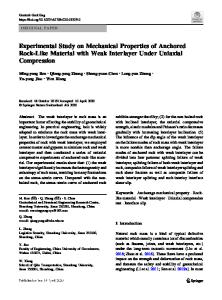Uniaxial and Triaxial Creep and Failure Tests on Rock: Experimental Technique and Interpretation
Modern test equipment and experimental techniques for uniaxial and triaxial failure tests, deformation tests, and creep tests are shown with special emphasis on tests on soft rocks and on time effects. A large number of test results, mainly on rock salt,
- PDF / 5,629,958 Bytes
- 53 Pages / 481.89 x 691.654 pts Page_size
- 86 Downloads / 289 Views
U. Runsehe Federal Institute for Geosciences and Natural Resources (BGR), Hannover, Germany
ABSTRACT Modem test equipment and experimental techniques for uniaxial and triaxial failure tests, deformation tests, and creep tests are shown with special emphasis on tests on soft rocks and on time effects. A large number of test results, mainly on rock salt, and their interpretation is given. Besides uniaxial and triaxial creep tests on cylinders, true triaxial tests on cubes and tension tests are also included. Determinaton of elastic constants, performance of stress drop and relaxation tests are presented as well. Emphasis is placed on the identification of the physical mechanisms for creep and fracture and on the determination of volume change.
1. INTRODUCTION
Knowledge of the mechanical properties of rocks is important for many engineering purposes, e.g. for the design of mines, tunnels, repositories, and deep wells, as well as for application in geophysics, tectonics, and seismology. In general, the elastic properties, creep, dilatancy, damage, fracture development, failure, and permeability are of interest for this purpose (see Langer, 1986). For corresponding model calculations one needs constitutive laws and equations describing the dependence of the properties on various parameters. In some special cases also probability density functions for the material properties have to be determined. N. D. Cristescu et al. (eds.), Visco-Plastic Behaviour of Geomaterials © Springer-Verlag Wien 1994
2
U. Hunsche
Most of the above mentioned properties are coupled, e.g. dilatancy and permeability. Therefore, this dependence has to be evaluated as well. It has also to be regarded that many properties are time or rate dependent, e.g. failure strength. Another difficult question is whether the material under question has a flow limit or a yield stress. For the development of reliable laws appropriate laboratory and field tests have to be performed. In this publication the experimental techniques for the laboratory creep and failure tests and their interpretation, and tests for determining elastic properties are described. Emphasis is placed on soft rock using rock salt as example. Creep is defined here as irreversible deformation without fracturing. A limited number of constitutive equations are shown for rock salt. The knowledge about rock salt is rather far advanced and it is often used as a model material, not only in rock mechanics but also in materials sciences. The knowledge of the experimental technique and the interpretation of tests is not only important for the experimentalist but also for the theoretician who wants to develop reliable and applicable constitutive equations since otherwise serious misinterpretations and mistakes are very likely to occur. Therefore, close cooperation between experimentalist and theoretician is an essential condition. Therefore, do never use experimental results without careful inspection of the whole test procedure. The development of appropriate constitutive equations can be made o
Data Loading...











